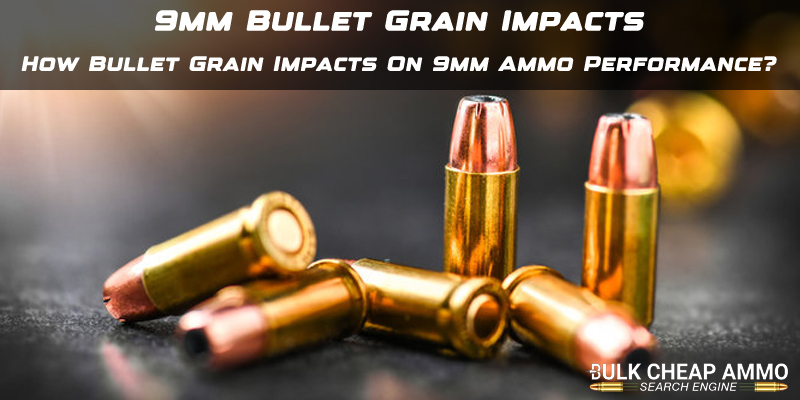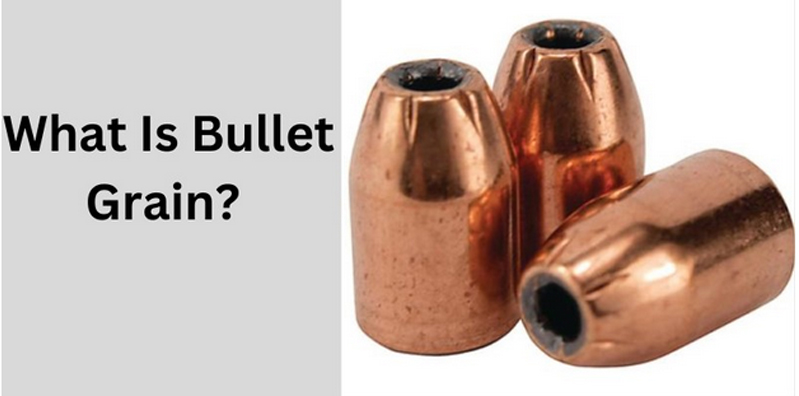How Bullet Grain Impacts On 9mm Ammo Performance?
Remember to consider bullet grain if you want to buy the perfect round for your defensive 9mm.
The choice of bullet grain is a critical factor that can significantly impact performance.
Understanding how bullet grain affects the performance of your 9mm bullet is essential for making informed choices as a shooter.

Previously, we have discussed differences between the two popular 9mm bullet grains: 115 vs. 124.
In this blog post, we'll delve into the world of bullet grain and explore its Impact on 9mm ammunition performance.
Let's get started…
Bullet Grain Explained
Let's start by defining what we mean by "bullet grain".

Bullet grain refers to the weight of the entire round projected from the gun and is measured in a unit of mass called grains.
One pound is equal to 7000 grains, and there are 437.5 grains in an ounce.
In 9mm ammunition, bullet weights typically range from 90 grains to 147 grains or more. The grain of a bullet is a fundamental aspect that can significantly influence how your ammunition performs.
How Bullet Grain Impact Performance?
Bullet grain, or mass, is one of the most important factors determining a bullet's performance.
Heavier bullets have more momentum and energy, allowing them to penetrate a target deeper and cause more damage.
Lighter bullets have less recoil, making them easier to control.
Here are some key ways in which bullet grain can impact the performance of 9mm caliber.
Muzzle Velocity And Bullet Grain
The weight of the bullet affects the velocity at which it leaves the barrel.
In general, lighter bullets tend to have higher muzzle velocities, while heavier bullets have lower muzzle velocities.
This can impact factors like bullet trajectory and the energy delivered to the target.
Lighter bullets, such as 90-115 grains, tend to have higher muzzle velocities. This results in flatter trajectories, which can be advantageous for accuracy at longer distances.
On the other hand, heavier bullets like 124-147 grains may have lower muzzle velocities.
Here is an example of two most popular self-defense ammo for 9mm pistols, HSTs in 124 grain and HSTs 147 grain with the same brand & line.
| Bullet Grain | Muzzle Velocity | Energy on Impact |
| 124 | 1150 fps | 364 ft-lbs |
| 147 | 1000 fps | 326 ft-lbs |
What does a 23-grain differential mean for muzzle velocity?
The 23-grain differential between the 124-grain and 147-grain HST 9mm ammunition results in a lower muzzle velocity for the 147-grain bullet.
According to Federal Premium, the 124-grain HST 9mm ammunition has a muzzle velocity of 1150 fps, while the 147-grain HST 9mm ammunition has a muzzle velocity of 1000 fps.
This difference in muzzle velocity is due to the increased mass of the 147-grain bullet. Heavier bullets require more energy to accelerate to the same velocity as lighter bullets.
Recoil and Bullet Grain
Recoil is the backward movement a shooter feels when the bullet is discharged. The weight of the bullet also affects recoil.
Heavier grain weight will have greater recoil force, while lighter grain will have less. Likewise, grain weight affects the energy felt by the target.
Lighter bullets produce less recoil, making them easier to control and allowing for quicker follow-up shots.
For those who prioritize recoil management, lighter bullets can be preferred.
Energy Transfer and Bullet Grain
The amount of energy transferred to a target by a bullet depends on several factors, including the bullet's mass, velocity, and shape. However, bullet grain is one of the most important factors.
Heavier bullets retain more energy at longer distances than lighter bullets. This can be crucial for self-defense, as it often results in deeper penetration and more consistent terminal performance.
Here is a table showing the energy transfer of some popular 9mm ammo loads:
Terminal Ballistics And Bullet Grain
Terminal ballistics refers to the behavior of a bullet upon Impact with a target, including how it penetrates, expands, transfers energy, and causes damage.
The grain (weight) of a 9mm bullet can significantly affect terminal ballistics.
Heavier bullets often penetrate deeper and may perform better against barriers like clothing or glass. Lighter bullets, however, may expand more rapidly but penetrate less.
Ammunition Design and Bullet Grain
Bullet weight is closely tied to the design of the bullet itself. When designing ammunition, manufacturers must consider the desired performance of the cartridge.
For example, if they are designing a self-defense cartridge, they will want a bullet penetrating deeply and transferring a lot of energy to the target.
If they are designing a target shooting cartridge, they will want an accurate bullet with low recoil.
For 9mm ammunition, the most common bullet weights are 115 grains, 124 grains, and 147 grains.
These weights offer a good balance of penetration, expansion, and recoil.
Consider both the grain and the design when selecting ammunition.
Firearm Compatibility and Bullet Grain
Firearm compatibility and bullet grain are closely related. Using the correct bullet grain for your firearm is important to ensure safe and reliable operation.
Not all firearms are optimized for the same bullet weight. Some pistols may perform better with specific bullet weights due to factors like barrel twist rate and recoil spring tension.
It's essential to consider your firearm when choosing bullet grain.
Advantages Of Lighter & Heavier Bullets
Advantages of a Lighter Bullet
- A lighter bullet means more speed and distance.
- Lighter bullets are good for competition and long-range shooting.
- Lighter bullets generate less recoil, making them easier to control and allowing for faster follow-up shots.
- Lighter bullets often increase muzzle velocities, improving accuracy at longer distances.
- Lighter bullets are less likely to over-penetrate, reducing the risk to bystanders in self-defense situations.
Advantages of a Heavier Bullet
- Heavier bullets mean more recoil & effectiveness.
- It's a good choice for defense, large game, and combat.
- Heavier bullets penetrate deeper and offer more consistent terminal performance.
- Heavier bullets are associated with improved stopping power, which is critical for self-defense.
- Heavier bullets have a more stable flight, enhancing accuracy in challenging conditions.
- It is ideal for subsonic loads in suppressed firearms, reducing noise.
What is the best grain bullet for a 9mm?
We can't say a particular grain is the "best" because it can vary depending on several factors:
- Purpose: Consider your intended use, whether it's self-defense, target shooting, competition, or anything else.
- Firearm Compatibility: Your specific firearm may perform better with certain bullet weights due to factors like barrel twist rate and recoil spring tension.
- Personal Preferences: Recoil tolerance and shooting style can influence your preference for bullet grain.
With these factors in mind, let's explore some common scenarios.
Self-Defense
9mm ammo is one of the most popular self-defense calibers. When choosing the bullet grain for self-defense, one of the most popular grains for self-defense is 124-grain ammo.
The 124-grain weight provides a good stopping power, unlocking the recoil potential that the 9mm is known for.
Some shooters love to use the lighter 115-grain loads instead for faster, flatter trajectories. Some people use 147 grain as they often provide reliable terminal performance.
But 124 grain is one of the most used 9mm bullet grains for self-defense.
Target Shooting
When it comes to target shooting, lighter bullets are often preferred. Bullets in the 115-grain range are popular for their reduced recoil, allowing quicker follow-up shots and less shooter fatigue during extended practice sessions.
However, 124-grain bullets are also suitable for target shooting, providing a balance between recoil and accuracy.
So both 115-grain & 124-grain will be good options for target shooting.
Competition Shooting
When choosing 9mm for competitive shooting, the "best" bullet grain can differ accordingly.
Many competitive shooters prefer lighter bullets, such as 115 grains, for faster follow-up shots and reduced recoil.
However, some competitive shooters, particularly those in events requiring greater accuracy, may opt for heavier bullets, like 147 grains, to take advantage of their stability.
Suppressor Use
If you plan to use a suppressor with your 9mm firearm, subsonic ammunition with heavier bullets, such as 147 grains, is often recommended.
These bullets stay below the speed of sound, reducing the sonic crack and noise associated with supersonic rounds.
Final Words
So, a bullet grain significantly impacts the performance of 9mm ammunition.
Generally, heavier bullets penetrate deeper and transfer more energy to their target, while lighter bullets are more susceptible to wind drift and drop.
The best bullet grain for a particular application will depend on various factors, including the type of firearm being used, the target being shot, and the distance at which the shot is being taken.

